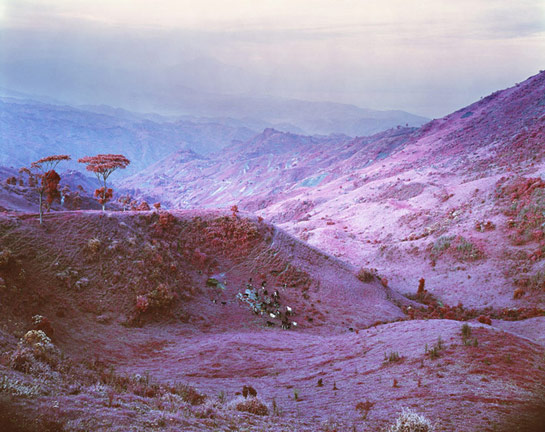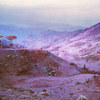A Letter from London: Immortal Nature @ Edel Assanti

In Edel Assanti’s current exhibition Immortal Nature, the esoteric architecture of the gallery space plays host to three mythological realms. The exhibition’s pre-occupation is one of tension with the natural world. Three humanly constructed territories; the Underworld, Earth and the Afterlife, show us glimpses of civilisation’s ever-present and ever-changing relationship with the earth we inhabit. (more)
Buzzed through the door of Edel Assanti, one walks off of Vauxhall Bridge Road into the dark, encompassing underworld. Kelly Richardson’s film Leviathan shows us a familiar but foreign swamp landscape where one struggles to distinguish one moment from the next. The camera, never straying from the same piece of swamp, gives the essence of a photograph in motion - a hypnotic illusion of this impenetrable environment that has come to represent the untrustworthy and ageless underworld.
It is however, as one begins to ascend the stairs to floor two, or rather ‘Earth’, that the exhibition’s premise becomes animate. Facing the entrance to floor two, Richard Mosse’s Herd at Dusk, 2011 greets the viewer with a mystifying view of a war torn Congo. At once recognisable and otherworldly, Mosse’s images stop the viewer in their tracks and silently demand attention. Like Richardson’s photographic-film, Mosse’s images reveal themselves slowly, filmically, to the viewer. It is a gradual process that begins with colour and ends beyond what the image can show - indeed, beyond what any image can show. With a dusting of white the violet and red landscape surrounds a solitary shepherd and his flock. Two red parasol-like trees disrupt this otherwise figureless panorama - if the shepherd were to die in this landscape, would anyone but his flock bear witness to his end? It is a bleak feeling that leaves the viewer in a bewildered space between the purple landscape of science fiction, and the solitary man unknown in his singularity, but recognisable as part of humanity.
To the right of this image sits Mosse’s other work of the same series. Like Herd At Dusk, Flower of the Mountain appears to slowly mutate within its own static presence. The landscape that plays backdrop to the central knoll appears to move in a slow motion vortex around this central feature with its sovereign flower. There is something primordial about this scene - the crowning feature of the hill once again instilling a feeling of isolation in the viewer, and consequently a feeling of desperation for the continual struggles in the Congo.
The photographer in both of these works has managed to conceal his presence and evoke a feeling of the distant remoteness that, in its own reserved way, emerges as the most poignant and provoking work in the exhibition.
Surrounded by images of car crashes and visions of the actuality of war, Mosse’s images sit passively. Playing off the literal destruction and desolation that surround them, they once again begin to metamorphose and shift in implication. However, it is when viewed alongside Piers Secunda’s Chinese Army Bullet Holes (PLA), 2009 that we begin to not only see Mosse’s images, but also to hear them. Suddenly, through Secunda’s work, the literality of war is manifested in violent bullet holes rupturing slabs of industrial floor paint. On returning to Mosse’s pictures from these uncompromising, severe ‘sculptures’, it is almost possible to witness the fireworks and listen to the sound of artillery echoing through the silent, unearthly valleys of the Congo.
~Christopher Thomas (cmlthomas88@yahoo.co.uk)
Immortal Nature is showing at Edel Assanti Gallery until 3rd March 2012.


